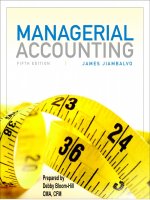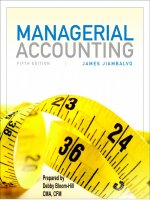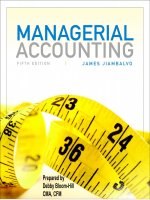Managerial accounting 5th jiambalvo ch05
Bạn đang xem bản rút gọn của tài liệu. Xem và tải ngay bản đầy đủ của tài liệu tại đây (1.32 MB, 36 trang )
Prepared by
Debby Bloom-Hill
CMA, CFM
CHAPTER 5
Variable Costing
Slide 5-2
Full (Absorption) Costing
Required by GAAP for external reporting
purposes
Inventory costs include:
Direct materials used
Direct labor incurred
Generally variable
Manufacturing overhead
Slide 5-3
Generally variable
Includes both fixed and variable costs
Learning objective 1: Explain the difference
between full (absorption) and variable costing
Variable Costing
Inventory costs includes:
Direct materials used
Direct labor incurred
Variable manufacturing overhead
Fixed manufacturing overhead treated
as a period cost
Helpful for internal decision making
Not allowed for GAAP reporting
Slide 5-4
Learning objective 1: Explain the difference
between full (absorption) and variable costing
Test Your Knowledge 1
Which of the following complies with GAAP
for external reporting purposes?
a. Absolute costing
b. Variable costing
c. Fixed costing
d. Full costing
Answer:
d. Full costing, also known as
absorption costing
Slide 5-5
Learning objective 1: Explain the difference
between full (absorption) and variable costing
Full (Absorption) Costing
Slide 5-6
Learning objective 1: Explain the difference
between full (absorption) and variable costing
Variable Costing
Slide 5-7
Learning objective 1: Explain the difference
between full (absorption) and variable costing
Difference Between Full and
Variable Costing
The only difference between full and
variable costing is their treatment of
fixed manufacturing overhead
Under full costing, fixed manufacturing
overhead is included in inventory
These costs enter into the determination of
expense only when the inventory is sold
Under variable costing, fixed
manufacturing overhead becomes a
period expense
Slide 5-8
Learning objective 1: Explain the difference
between full (absorption) and variable costing
Variable Costing Income
Statement
Classifies all expenses in terms of their
cost behavior, either fixed or variable
With variable and fixed expenses
separated, the contribution margin can be
presented
Contribution margin is revenues minus total
variable expenses
The contribution margin allows users to
make reasonable estimates of how much
profit will change with changes in sales
Slide 5-9
Learning objective 2: Prepare an
income statement using variable costing.
Variable Costing Income
Statement
Sales are $100,000 and contribution
margin is $65,000
Calculate the contribution margin ratio:
Calculate the change in contribution
margin if sales change by $10,000
$10,000 * 0.65 = $6,500
Slide 5-10
Learning objective 2: Prepare an
income statement using variable costing.
Variable Costing Income
Statement Example
Slide 5-11
Learning objective 2: Prepare an
income statement using variable costing.
Full Costing Income Statement
Example
Slide 5-12
Learning objective 2: Prepare an
income statement using variable costing.
Variable Costing vs. Full
Costing Income Statement
The full costing income statement
cannot be used to estimate the increase
in profit due to an increase in sales
The reason is that cost of goods sold
includes both fixed and variable costs
The fixed costs will not increase when
sales increase
Under full costing we do not know how
much of cost of goods sold is fixed or
variable
Slide 5-13
Learning objective 2: Prepare an
income statement using variable costing.
Example - Clausen Tube
Selling price $2,000
Variable costs (per unit):
Materials = $600/unit
Labor = $225/unit
Variable mfg. overhead = $75/unit
Variable selling expense = $40/unit
Fixed mfg. overhead = $1,200,000
Production = 5,000 units
Slide 5-14
Learning objective 3: Discuss the effect of
production on full and variable costing income.
Clausen Tube
Full Cost per Unit
Full cost per unit for 5,000 units is
calculated as follows:
Total Material Costs
$600 per unit
Total labor costs
$225 per unit
Total variable OH
Fixed Overhead
Full Cost per Unit
Slide 5-15
$75 per unit
$1,200,000/5,000
units
$240 per unit
= $1,140 per unit
Learning objective 3: Discuss the effect of
production on full and variable costing income.
Clausen Tube
Variable Cost per Unit
Variable cost per unit for 5,000 units is
calculated as follows:
Total Material Costs
$600 per unit
Total labor costs
$225 per unit
Total variable OH
Variable Cost per Unit
Slide 5-16
$75 per unit
= $900 per unit
Learning objective 3: Discuss the effect of
production on full and variable costing income.
Clausen Tube – Income
Statement
Slide 5-17
Selling price = $2,000/unit
Full cost = $1,140/unit
Variable cost = $900/unit
Variable selling expense = $40/unit
Fixed overhead = $1,200,000
Fixed selling expense = $100,000
Fixed administrative expense= $500,000
Learning objective 3: Discuss the effect of
production on full and variable costing income.
Clausen Tube – Income
Statements
Production equals sales (5,000 units)
Slide 5-18
Learning objective 3: Discuss the effect of
production on full and variable costing income.
Quantity Produced Equals
Quantity Sold
When the quantity produced equals the
quantity sold, there is no difference
between net income calculated using full
cost versus variable costing
Since all units produced are sold, no fixed
cost ends up in ending inventory
The only difference is that variable costing
calculates the contribution margin
Slide 5-19
Learning objective 3: Discuss the effect of
production on full and variable costing income.
Clausen Tube – Income
Statements
Production (6,000 units) is greater than
sales (4,800 units)
Slide 5-20
Learning objective 3: Discuss the effect of
production on full and variable costing income.
Quantity Produced is Greater
Than Quantity Sold
When the quantity produced is greater
than the quantity sold income will be
greater under full costing as opposed to
variable costing
Under full costing, inventory cost includes
fixed manufacturing overhead
Under variable costing, fixed
manufacturing overhead is a period cost
Slide 5-21
Learning objective 3: Discuss the effect of
production on full and variable costing income.
Clausen Tube – Income
Statements
Production (6,000 units) is less than sales
(7,200 units)
Slide 5-22
Learning objective 3: Discuss the effect of
production on full and variable costing income.
Quantity Produced is Less
Than Quantity Sold
Then the quantity produced is less than the
quantity sold, income will be greater under
variable costing as opposed to full costing
Beginning inventory under fixed costing
includes fixed manufacturing overhead
When the beginning inventory is charged to
cost of goods sold the charge will be higher
under full costing
Slide 5-23
Learning objective 3: Discuss the effect of
production on full and variable costing income.
Variable Costing for External
Reporting
Slide 5-24
Learning objective 3: Discuss the effect of
production on full and variable costing income.
Test Your Knowledge 2
Summit Manufacturing, Inc. produces snow
shovels. The selling price is $25. Costs are:
Production is 42,000 snow shovels.
Calculate full cost per unit.
Slide 5-25
Learning objective 3: Discuss the effect of
production on full and variable costing income.









